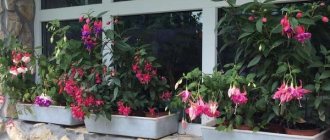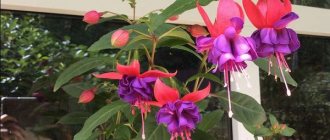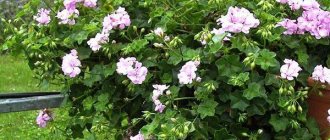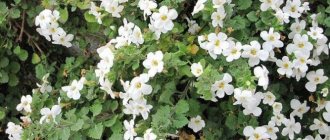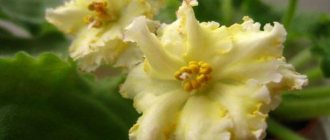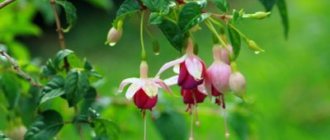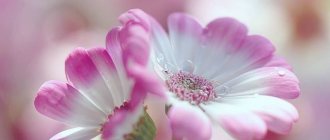In the Fuchsia genus of the Fireweed family (Onagraceae), there are 113 (1) evergreen and deciduous species. The genus is named after the famous German scientist Leonard Fuchs, a botanist and physician who first described it in his fundamental work “The History of Plants.”
In the natural flora, fuchsias are found in Central and South America, as well as in New Zealand. In culture today, along with individual species and their varieties, hybrid fuchsia (Fuchsia hybrida) is most often grown.
In nature, the life forms of fuchsias are shrubs, shrubs, subshrubs and even small trees with opposite or whorled oval or lanceolate leaves. The surface of the leaves is smooth (matte, glossy) or velvety.
Any fuchsia has a bright personality thanks to drooping flowers of various colors and original shapes. They are called ballerinas, gypsy earrings, Chinese lanterns, dolls, trinkets. Fuchsia flowers are an excellent subject for both spectacular photographs and thoughtful consideration. And the structure of the flower is very convenient for artificial pollination when creating new varieties. It consists of a tubular calyx that ends in four spreading sepals, a corolla with straight petals that form a crown, long stamens and a pistil (ballerina's foot), which hang a few centimeters below the petals.
Flowers are simple (non-double), semi-double, double. Semi-double fuchsias have up to 7 petals in a flower, while double fuchsias have 8 or more petals.
Fuchsias bloom from spring to late autumn, and under favorable conditions almost all year round.
The fruit is an edible berry. The seeds are very small, almost flat, light brown.
Types and varieties of fuchsia
At home, 8 types of fuchsias are most often grown.
Fuchsia triphylla. Forms a dense bush when grown in pots up to 60 cm high. The leaves are ovate, about 8 cm long, the upper side of the leaf is reddish-green, the lower side is brown-red. Bell-shaped flowers are collected in a brush. Their color is determined by the bright coral sepals that form a tube. The petals are the same color, very short, barely protruding from the calyx.
Flowering is abundant and lush - from May to October.
In winter, this fuchsia is kept at a temperature not lower than 10 ° C and not higher than 15 ° C. In summer it can withstand high temperatures and even bright sun.
Fuchsia trifolia gave rise to triphylla hybrids, on the basis of which excellent varieties for hanging baskets and flower pots emerged:
- Thalia - with bright orange flowers;
- Mantilla - with bright red flowers;
- Coralle – with coral-colored flowers;
- Elfriede Ott – with peach-pink flowers.
Fuchsia trifolia.
Photo: pixabay.com Magellanica . This evergreen fuchsia is the most winter-hardy and hardy. It comes from the mid-mountains of the Andes and is capable of wintering under snow even in central Russia when covered with spruce branches and light hilling. However, plants are usually grown in containers and placed in a cool (3–5 °C) room for the winter.
Its leaves are violet-green, about 4 cm long. The flowers are solitary or in racemes of 3-5 pieces, with a creamy-red calyx and a purple corolla.
Blooms from May to October.
This fuchsia also has interesting varieties:
- Blue Sarah - with lilac-pink flowers;
- Contrast – with purple-red flowers;
- Madame Cornelissen - with red and white flowers;
- Riccartonii – with red-violet flowers;
- Tom West - with purple-red flowers and variegated leaves.
Fuchsia Magellanica.
Photo: pixabay.com Bolivian fuchsia (Fuchsia boliviana). One of the most beautiful fuchsias. An evergreen shrub, grown in containers about 1 m high, grows well indoors and tolerates pruning easily. With good care it blooms almost all year round. Prefers partial shade and sufficient moisture. Overwinters at a temperature of about 10 °C.
The leaves are large (up to 15 cm long and about 6 cm wide) dark green with a velvety surface and a serrated edge. The flowers are dark red, tubular, with a long (about 6 cm) calyx and a short corolla (2 cm), collected in lush racemes at the ends of drooping peduncles. This fuchsia has an Alba - with a white skirt.
Fuchsia Boliviana. Photo: pixabay.com
Bright red fuchsia (Fuchsia coccinea). Shade-tolerant fast-growing shrub. The shoots are thin, hanging. The leaves are oval on short petioles. Flowers with long red calyxes and a purple corolla.
Blooms from April to October.
Fuchsia fulgens. Rare view. Well-leafed shrub up to 1.5 m high. The shoots are thin, flexible, reddish. The leaves are large, up to 15 cm long, broadly ovate, with a finely toothed edge, purple-green. The flowers are collected in drooping apical inflorescences-tassels. They have dark pink tubular calyxes about 5cm long and small red petals. This fuchsia has the most delicious and largest (up to 5 cm long) fruits with a tart lemon aroma. Unfortunately, they only ripen in nature.
Blooms from spring to autumn.
The most popular varieties:
- Swanley Yellow - with bright orange petals and cream sepals;
- Traudchen Bonstedt - with pale salmon sepals and bright salmon petals.
Fuchsia brilliant.
Photo: pixabay.com Small-leaved fuchsia (Fuchsia microphylla). A low-growing shrub with reddish shoots and small (up to 4 cm long), reddish-green pointed leaves with a serrated edge. The flowers are red-purple, small, solitary, located in the axils of the leaves.
Blooms from spring to autumn.
Fuchsia graceful (Fuchsia gracilis). Shrub up to 1 m high, with thin reddish shoots. The leaves are 5–6 cm long, green with reddish veins, oval-lanceolate in shape with a serrated edge and a smooth surface. The flowers are collected in gracefully cascading racemes. They have bright red calyxes and a purple corolla-skirt.
Fuchsia is elegant. Photo: YouTube
Hybrid fuchsia (Fuchsia hybrida). A widespread indoor plant, the number of its varieties has already exceeded a thousand. They differ in the shape of the flower, its size, the degree of terry, the color of the calyx (usually it is not green, but red or white in different shades) and corolla (white, pink, red, purple). Bicolor varieties are replete with spectacular color combinations.
Fuchsias also differ in flower size - small-, medium- and large-flowered. There are also unique forms - with palm-sized flowers.
Fuchsia hybrid. Photo: pixabay.com
The most popular – beautiful and unpretentious varieties include:
- Alfred de Groot - a resilient variety that easily adapts to growing conditions, a compact, erect bush, green leaves, ovate with a serrated edge, simple flowers with a soft pink calyx and a pink-violet corolla;
- Annabel - thin, drooping shoots, green leaves, lanceolate with a sharp tip and jagged edge, large, double flowers, with a white skirt and light pink sepals, dark pink stamens;
- Ballerina is an erect bush, large double flowers with scarlet sepals and a lush pale pink corolla, dark pink stamens;
- Cecile is an erect, highly branched bush, densely double flowers with light red sepals and bluish-lilac wavy petals;
- Clara – ampelous variety, large, double flowers, with white sepals and a cherry skirt in light strokes, pink stamens;
- Marinka is an ampelous variety, the flowers are simple, medium-sized, raspberry-red, blooms for a long time and very abundantly;
- Millenium is a very spectacular variety, an erect bush, large, double flowers, with purple-red sepals and a dark purple, almost black, rounded corolla;
- Niedersachsen - a classic ampelous variety, the flowers are large, semi-double and double, with dark pink sepals and a snow-white skirt;
- Prince of Peace - an unpretentious ampelous variety, green ovate leaves with a sharp tip and finely toothed edge, simple flowers with a white calyx and a bright red or purple-red corolla;
- Santa Clara - ampelous variety, large, double flowers, cherry-colored skirt with white strokes, white calyx.
- Voodoo - erect plants with densely double large flowers, bright red sepals, blue-violet corolla petals, wavy.
Bush varieties
Avid flower lovers, despite their established favorites, are attracted to new varieties. Both beginners and experienced plant growers should study fuchsia varieties before planting: knowledge of their characteristics will allow them to grow a high-quality flowering, healthy plant.
Rohees New Millennium
One of the most fascinating fuchsia varieties. The bush is compact in size, its height is only about 40 cm. The shoots are strong, woody, making the flower suitable for forming into a tree. The leaves are elongated oval in shape, with a pointed tip. Rich light green color, smooth, with a pronounced skeleton. The flowers are medium and large, directed downwards. The variety is presented in one contrasting color combination: the sepals are light pink, the skirt is the color of overripe cherries. This color combination makes fuchsia look exotic.
Millennials complain about the problem of “reluctant” sluggish flowering out of season. In most cases, the problem can be resolved with timely feeding: the variety is sensitive to the lack of nutrients in the soil.
Andromeda
Fuchsia bush Andromeda is a tall plant, its height can reach up to 90 cm. The shoots quickly become woody, which makes it possible to grow the bush in the form of a trunk, but it is also incredibly beautiful growing in any order. Growth is fast.
Caring for fuchsia at home
Photo: pixabay.com
In their homeland, fuchsias grow under the forest canopy, with high air humidity and moderate temperatures, illuminated by sunlight “strained” by the foliage. There is a significant difference between day and night temperatures. Similar conditions must be created for plants in our homes.
Priming
Fuchsias are quite suitable for universal soil mixtures for indoor plants with a slightly acidic reaction environment, however, to improve aeration, you need to add pieces of charcoal, perlite, vermiculite, as well as a little sand and clay soil or hydrogel to retain moisture.
You can prepare the soil for fuchsia yourself by mixing peat, humus or fertile soil and sand in a ratio of 2:3:1 (2). The earth needs to be warmed up or shed with a pink solution of potassium permanganate.
A layer of expanded clay drainage is poured onto the bottom of the pot, at least 1/4 of its height. In the absence of drainage, plants are at risk of waterlogging.
Lighting
Fuchsias need bright, but diffused light; they can also withstand light shading. Windows facing east or west are best. Or you can place the plant a couple of meters from the south window, protecting it from direct sunlight.
The location must be determined immediately, so as not to rearrange or rotate the plant later, especially during the period of budding and flowering. Fuchsias do not like this and can shed not only buds, but also leaves.
In summer, it is advisable to take indoor fuchsias out into the fresh air, but not under the scorching sun. In the garden they are placed in partial shade or on outside windowsills with full morning sun.
Temperature
During the period of active growth and flowering, the favorable temperature for fuchsias is from 18 to 25 °C, the optimal temperature is about 20 °C. Temperatures above 30 °C are depressing. In winter, in the stage of relative dormancy, the most suitable temperature is 5 - 10 ° C, taking into account the requirements of individual varieties and species (3), (4). In a cool room, the leaves may fall off, but new ones will grow in the spring. The room where fuchsias grow must be regularly ventilated, avoiding drafts.
Garden fuchsias can be kept in a frost-free basement until returned to open ground in the spring.
Humidity
Fuchsias need to be watered regularly, as the top layer of the substrate dries out, but moderately, avoiding either complete drying out or waterlogging of the earthen clod. It is recommended to drain excess water from the trays. In the warm season, fuchsias are responsive to spraying with settled water.
The best time to water is early in the morning, so that the plants actively absorb moisture before noon.
In autumn, watering is reduced, and in winter it is practically stopped, but make sure that the soil does not dry out.
Fertilizers
Fuchsias are fed with complex mineral fertilizers for indoor flowers or complete fertilizer with microelements. It is better to use fertilizer solutions.
Photo: pixabay.com
Feeding
Fuchsias are fed from mid-March to September every 7 to 10 days. From time to time, it is useful to water the plants with an infusion of mullein or chicken manure diluted 1:10. In September-October - 1 feeding per month, and then they are stopped until spring (5).
After transplanting into fresh soil, fuchsias begin to be fed after about 30 days.
Trimming
In order for fuchsias to be lush and bloom profusely, they need to be regularly pruned and shoots pinched, as the flowers appear on new growths. The main pruning is done in early spring - early March, or in the fall, after flowering and active growth are completed. Bushes can be shaped into different shapes.
During the growing season, shoots are shortened as necessary, sometimes even by 1/3, and thin and weak branches are removed. Usually the tops of the side shoots are pinched at the level of 2 - 3 pairs of leaves, due to this the fuchsia branches better and lays more buds. Pinching can be repeated every time three pairs of leaves are fully formed on the next side shoot (6).
During flowering, faded flowers are regularly removed to stimulate the formation of new ones.
Fuchsia ampelous - planting and care outdoors
Fuchsia growing and care in the garden, in open ground
Evenly falling shoots of the plant, at the peak of flowering, turn into a mini-floral waterfall. But for this you need to create suitable conditions for them.
Landing
The flower is grown using seeds and rooting cuttings.
The first method is usually used by breeders to obtain new varieties. It is painstaking and time-consuming; moreover, it does not guarantee a variety with maternal characteristics.
Rooted fuchsia cuttings
For amateur gardeners, it is preferable to propagate the variety you like by cuttings. It is enough to place the parts of the shoots remaining after pinching (15-20 cm) in water for 10-14 days. After the cutting takes root, it can be planted in a permanent place. To quickly get a dense bush, you can plant several cuttings in a pot. For good root formation, moderate temperatures of up to 20-23 ° C and regular watering are needed.
Seedlings received by mail or purchased in a store are transplanted using the transfer method from a container into a container, with a mandatory layer of drainage, and topped with soil.
For fuchsia to feel good you need:
- place it in an area protected from drafts and wind;
- the place for growing must be selected, avoiding the south side;
- provide the plant with a neutral soil pH;
- Use soil for planting that is permeable and light;
- Feed regularly, every 2-3 weeks - this will make flowering longer and more generous.
Important ! Fuchsia does not like heat and does not tolerate direct sunlight.
In summer, the bush needs frequent watering; it is also recommended to moisten the above-ground part with a sprayer. You need to focus on the drying soil around the roots of the plant; excess moisture can harm them.
Propagation of fuchsia at home
Photo: YouTube
To propagate fuchsias, 2 methods are usually used.
By cuttings. Cuttings are often combined with spring pruning in early March, but this can be done until August.
Green cuttings about 12 cm long are rooted in damp sand or a mixture of peat and sand, using hormones to stimulate root formation (Kornevin). Roots usually appear after 3 weeks. Rooted cuttings are transplanted into pots filled with disinfected soil mixture.
Seeds. When propagating fuchsias by seeds, they are sown on top of a moist substrate of peat and sand (1:1), covered with film or glass and placed in a warm (20 - 25 ° C) bright place. Shoots appear within 2 weeks, after the seedlings have formed 5 - 6 leaves, they are planted in pots with a diameter of 5 cm with the same soil (7).
Plants from seeds bloom within 4 to 5 months.
Transplanting fuchsia at home
Fuchsias are replanted annually in the spring, before active growth begins, when the roots of the plant have completely reclaimed the soil in the old pot. A new pot that is too large is not suitable; it should be slightly larger than the previous one - 2 - 4 cm in diameter. In the process of replanting fuchsias, it is sometimes necessary to trim roots that are too long (8).
To create a beautiful cascade of fuchsia flowers, you can plant several plants at once in one wide flowerpot, and immediately place them closer to the edges and obliquely to give the future bush a flowing shape. During the growth of green mass, the pot is regularly turned to the light in different directions - then the group will form evenly and lushly.
Ampel and semi-ampel varieties of fuchsia at first have the shape of a bush, but over time, under the weight of numerous buds and flowers, the flexible stems begin to bend beautifully and hang over the edge of the flowerpot. To prevent fragile branches from breaking, they are tied to supports.
THIS IS INTERESTING
One of the first synthetic dyes, obtained in 1856, was given the name “fuchsin” by chemists due to the similarity of the color of its aqueous solutions to the color of fuchsia flowers.
How to shape fuchsia
Bacopa ampelous - growing and care at home
To get a thick, branched bush, pinch the flower as it grows. The first pinch is done after the cutting has taken root. Pinch (remove) the upper part of the shoot, thus stimulating the lateral buds to grow and flower.
The shoots that grow from them are also pinched, leaving 2-3 nodes for branching. Thus, you can form a lush plant in 3-4 pinchings. Shoots growing from the ground are also pruned.
Pinching the plant plays the role of formative and rejuvenating pruning and prevents the stems from becoming bare.
Shoots of hanging and hanging varieties are shortened by a third of their length in the spring. It is important that the branches of the flower are the same on all sides. Then during the flowering period the bush will be harmonious and uniform. In an adult plant, pinch out every 3-4 internodes.
Fuchsia is a flexible plant, it grows quickly; bush and hanging varieties can be used to form a standard.
Fuchsia on a trunk
The grown cuttings are tied to a support in several places. The lower leaves and branches on the future trunk are removed, leaving 3-4 pairs of leaves at the crown. The top is pinched after the plant reaches the desired height. After this, the stage of crown formation begins, pinching the shoots after 2 - 3 internodes. Over time, the fuchsia trunk becomes woody and the crown branches out.
A thicker trunk can be obtained by weaving 2-3 shoots of one plant.
Fuchsia blooms on young shoots. The shorter the pinching (1-3 buds), the better the young shoots develop.
Fuchsia diseases
Powdery mildew. Fuchsias are often affected by powdery mildew, especially in high humidity. Small spots dusted with a white powdery coating appear on the plants. They quickly increase in size, acquiring a brownish or gray color. Affected leaves dry out.
Biological products help against this fungal disease: Fitosporin-M, Alirin-B, Gamair, Pseudobacterin-2, Planriz. In case of severe damage, spray with Fundazol (9) (1 g/l of water).
Dry rust . Dangerous fungal disease. The affected plant develops rusty-brown spots and stripes on the leaves, as well as dusty pustules.
Diseased shoots are removed, and the plants are sprayed with Bordeaux mixture 2–3 times at intervals of 10–12 days.
Photo: YouTube
Gray rot. Fuchsia roots often suffer from it, especially when overmoistened . When replanting plants, it is important to pay attention to the roots. They should be light, almost white and hard. If the roots are brownish and soft, then this is a sure sign of gray rot. A characteristic gray coating also appears on the leaves.
For prevention, Trichodermin, the preparations Zaslon, Barrier, etc. are added to the soil. All affected parts of the plants are removed and the fuchsias are sprayed with fungicides Abiga Pik, Skor (9), and copper sulfate.
Semi-ampel varieties
Fuchsias are interesting in shape and change their appearance. Experimenting with the formation of a bush will create a unique charm and zest in the room or on the site.
Fairy
A medium-sized bush with delicate lush flowers of incredible beauty. Shoots reach sizes up to 35 cm.
The leaves are quite large, rounded, moderately green in color. They have brown veins. The flowers are voluminous. The sepals are a cool milky pink hue, the petals are elongated, terry, raised and curled. The skirt is lilac-violet, with a blue tint, silky.
A relatively unpretentious variety to care for, it grows and develops quickly. The shoots become woody, which makes it possible to form a trunk.
Golden Monique
A weakly branching bush. Blooms abundantly, flowers are small. The shoots are woody and can be grown in the form of a small tree.
The leaves are decorative and look beautiful in the dormant phase. They have a golden-green hue, decorated with reddish veins. The flowers are double, the sepals are deep reddish-pink. The skirt is bright pink.
The unpretentious fuchsia of this variety winters well and loves good lighting. With a lack of sun, the leaves turn green and lose their yellow tint. Cuttings quickly and easily produce roots.
La Fiesta
Medium-sized variety, shoots reach a length of up to 40 cm. The shoots are strong, branching. The buds are elongated, flowering is abundant.
The leaves are light to medium green with purple veins. The flowers are large, the sepals are oblong, white with pale green tips. The skirt is bright red, with a raspberry tint, and decorated with pink strokes.
Cuttings root slowly.
Fuchsia pests
The main pests of fuchsia are aphids, spider mites, whiteflies, and mealybugs.
Aphid. It is clearly visible, especially in colonies. Damaged plants have deformed shoot tips and curled leaves. They become covered with sticky secretions of insects, on which a sooty fungus settles.
If the number of aphids is insignificant, they can be washed off or the infested branches can be cut off. Severely affected plants are treated with insecticides Biotlin Tanrek, Karate or the biological product Fitoverm (9). Apply pesticides according to instructions.
Spider mites. They pierce the integumentary tissue of the leaves and suck out the juice from them. Therefore, the leaf blades become covered with small white dots, and if severely damaged, they become discolored and dry out. Mass reproduction of ticks occurs in dry, warm air.
Prevention - regular showers. Fight - spraying with infusions of garlic, chamomile, yarrow or acaricides - Actellik, Neoron, Fitoverm (9).
Whitefly. When damaged by whiteflies, discolored, blurry spots appear on the leaves, and when insects multiply massively, sticky discharge appears. Whiteflies are easy to spot, but difficult to fight.
They mainly use insecticides Actellik, Confidor, Mospilan - according to the instructions for the drugs. Plants are treated several times with an interval of 5 days, as new generations of pests emerge from the laid eggs.
Popular questions and answers
We talked about growing fuchsia and the problems that arise with a candidate of agricultural sciences. Sciences Irina Titova.
How to choose fuchsia?
Fuchsias are grown in bush, ampelous and standard forms. Almost any variety can be grown in all three varieties, and bush fuchsia can also be made into an ampel or standard form and vice versa. So the main thing for a florist is the beauty of the flowers, and this is a matter of taste.
What kind of pot is needed for fuchsia?
For fuchsias, choose light-colored pots and flowerpots, or cover them from the sun. Ceramic products are preferred. It is useful to cover the soil surface with light wood chips, small pebbles, and marble chips to protect the roots from overheating.
Why do fuchsia leaves fall off?
The most likely reason for fuchsia leaves to fall is warm, dry air. Spray the plants with a spray bottle every 2 days or more often. If possible, expose them to the open air.
Why do fuchsia leaves dry out?
This happens when there is a lack of moisture and, conversely, when the soil is waterlogged in the cold and dark season. If spots appear on the leaves, fungal diseases are likely developing. The lower leaves often dry out and fall off due to insufficient watering or poor lighting.
Why do fuchsia buds fall off?
Most likely this is the result of a violation of the watering regime - too much or too little water. Other possible reasons are very high or, conversely, low air temperature and lack of light. Sometimes the buds fall off if the plant is moved to a new place or turned in relation to the light source.
Why does fuchsia wither?
This can happen if the plant is kept in a warm room in winter, as well as if there is a lack of water and nutrients, or if there is not enough light during the period of active growth. Another reason is overheating of the earthen coma.
Why doesn't fuchsia bloom?
Mature fuchsia does not bloom under unfavorable conditions. Analyze how your fuchsia lives. Surely establish the reason, take action, and the fuchsia will bloom.
Sources
- Fuchsia // The Plant List https://www.theplantlist.org/1.1/browse/A/Onagraceae/Fuchsia/
- Farm laborer E.R. Fuchsia // M.: Kladez-Buks, 2006
- Bartlett G. Fuchsias // The Crowwood Press Ltd, 2007
- Bartlett G. Fuchsias Step by Step to Growing Success // The Crowwood Press Ltd, 1996
- Shvelidze S. Fuchsia. At the peak of fashion // M.: Fiton+, 2006
- Nicholas J. Fuchsias // Aquamarine, 2008
- Markina T. Fuchsia. Maintenance, breeding, care // M.: InterService, Presscom, 2004
- Dubrovskaya S. Fuchsia: development and care // M.: Ripol Classic, 2006
- State catalog of pesticides and agrochemicals approved for use on the territory of the Russian Federation as of July 6, 2022 // Ministry of Agriculture of the Russian Federation https://mcx.gov.ru/ministry/departments/departament-rastenievodstva-mekhanizatsii-khimizatsii- i-zashchity-rasteniy/industry-information/info-gosudarstvennaya-usluga-po-gosudarstvennoy-registratsii-pestitsidov-i-agrokhimikatov/
Use in landscape design
Due to its high decorative value and abundant flowering, the flower is often used as a landscape plant. With its help, they create vertical decoration of walls, gazebos, and fences. Hanging and potted crops are used to decorate verandas, terraces, windows, and arches. Standard varieties are perfect for decorating areas, paths, and local areas. Bush varieties are used in the design of flower beds and front gardens. Numerous varieties differ in their flowering period. This allows you to arrange them to create highly decorative landscape compositions.
Fuchsia is suitable for cultivation as an ornamental garden crop, therefore the beautiful flowering plant is widely used in landscape design
Fuchsia is a beautifully flowering and unpretentious plant. It's no surprise that it is often found in homes and gardens. Its fabulous appearance attracts attention at first sight , and the variety of varieties and hybrids makes it easy to surround yourself with an atmosphere of bright colors and intricate shapes.

